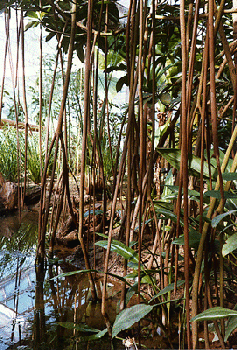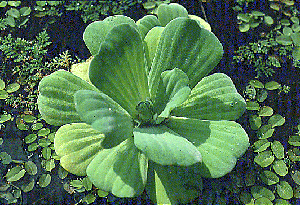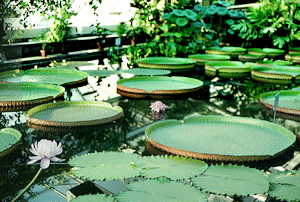Greenhouses - House O
|
Herbaceous lianas growing here in summer include Cucurbitaceae like Momordica charantia and Trichosanthes cucumerina. The sensitive plant Mimosa pudica dwells well in the hot and humid atmosphere and can be observed and touched here. Photo right: Pistia stratiotes.
One of the main attractions of the garden during the summer months are the two species of the giant waterlilies Victoria amazonica from the Amazon and Orinoco, and Victoria cruziana from the Parana River. Other Nymphaeaceae like Nymphaea gigantea, a large blue flowered water lily from Australia and New Guinea, Euryale ferox from tropical E-Asia, and a number of species and cultivars of waterlilies of the genus Nymphaea are also noteworthy. Photo left: Tropical water lilies.
Around the Victoria pond several woody or herbaceous lianas with showy flowers can be seen in summer: Thunbergia laurifolia (Acanthaceae), the yellow-flowered Allamanda cathartica (Apocynaceae), and Argyreia nervosa (Convolvulaceae) with beautiful leaves are quite attractive. On the contrary, the large-flowered Aristolochia grandiflora, and A. maxima (Aristolochiaceae) are quite repugnant once you are close enough to inhale the strong odour emitted by the flowers (in late summer), a means to attract flies as pollinators. At the entrance of the glasshouse complex, the first display catching the attention of the visitor are the aquariums. Some entirely or mostly submerged growing species of typical water plant families are shown here, particularly numerous in the genus Vallisneria (Hydrocharitaceae) and Echinodorus (Alismataceae). The Araceae are well represented by various species of Cryptocoryne. The finely pinnatisect leaves of Myriophyllum have surprising imitators in other families, particularly on the submerged stem parts of species of Limnophila and Hydrotriche (Scrophulariaceae). Aquatic representatives of further flowering plant families like Acanthaceae, Aponogetonaceae, Amaryllidaceae, Compositae, Cyperaceae, Lythraceae, and Onagraceae can be found here as well. B. Leuenberger |
Continue the tour of the greenhouses...

 Tropical swamp plants shown here include an impressive stand of mangroves, with Rhizophora mangle (Rhizophoraceae) forming its typical stilt roots. It grows well without the brackish water it tolerates in nature. Bruguiera sexangula from SE Asia is also successfully grown here, flowers regularly, and even sets fruit showing the viviparous development of the seedling with its marked hypocotyl. Further mangroves cultivated here are Laguncularia racemosa (Combretaceae) and Aegiceras corniculatum (Myrsinaceae), as well as a few other plants of the coastal mangrove forests such as the mangrove fern (Acrostichum aureum). Freely floating plants like Pistia stratiotes of the Araceae, Eichhornia crassipes of the Pontederiaceae, and the fern Salvinia oblongifolia grow vigorously during the summer months when the conditions here in the glasshouse are truly tropical. Other large swamp plants are Typhonodorum lindleyanum (Araceae) from Madagascar, Prionium serratum (Juncaceae) from S-Africa, and (Cyperus papyrus), the true papyrus plant used in ancient times to make paper. Photo left: mangroves.
Tropical swamp plants shown here include an impressive stand of mangroves, with Rhizophora mangle (Rhizophoraceae) forming its typical stilt roots. It grows well without the brackish water it tolerates in nature. Bruguiera sexangula from SE Asia is also successfully grown here, flowers regularly, and even sets fruit showing the viviparous development of the seedling with its marked hypocotyl. Further mangroves cultivated here are Laguncularia racemosa (Combretaceae) and Aegiceras corniculatum (Myrsinaceae), as well as a few other plants of the coastal mangrove forests such as the mangrove fern (Acrostichum aureum). Freely floating plants like Pistia stratiotes of the Araceae, Eichhornia crassipes of the Pontederiaceae, and the fern Salvinia oblongifolia grow vigorously during the summer months when the conditions here in the glasshouse are truly tropical. Other large swamp plants are Typhonodorum lindleyanum (Araceae) from Madagascar, Prionium serratum (Juncaceae) from S-Africa, and (Cyperus papyrus), the true papyrus plant used in ancient times to make paper. Photo left: mangroves.
